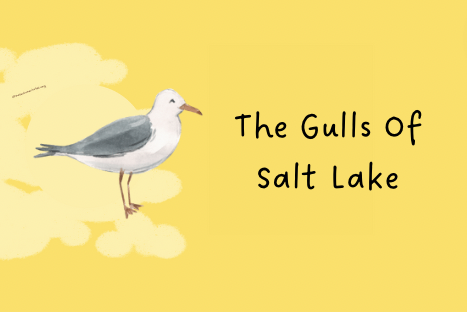The story I will tell you is about something that happened many years ago.
A brave little company of pioneers from the Atlantic coast crossed the Mississippi River and journeyed across the plains of Central North America in big covered wagons with many horses, and finally succeeded in climbing to the top of the great Rockies and down again into a valley in the very midst of the mountains. It was a valley of brown, bare, desert soil in a climate where almost no rain falls. Still, the snow on the mountaintops sent down little streams of pure water, the winds were gentle, and lying like a blue jewel at the foot of the western hills was a great lake of salt water—an inland sea. So the pioneers settled there and built huts and cabins for the first winter.
It had taken them many months to make the terrible journey; many had died of weariness and illness on the way; many died of hardship during the winter; and the provisions they had brought in their wagons were so nearly gone that, by spring, they were living partly on roots, dug from the ground. All their lives now depended on the crops of grain and vegetables they could raise in the valley. They made the barren land fertile by spreading water from the little streams over it—what we call “irrigating”; and they planted enough corn, grain, and vegetables for all the people. Everyone helped and watched for the sprouting with hopes, prayers, and careful eyes.
In good time the seeds sprouted, and the dry, brown earth was covered with a carpet of tender, green, growing things. No farmer’s garden could have looked better than the great garden of the desert valley. And from day to day, the little shoots grew and flourished till they were all well above the ground.
Then a terrible thing happened. One day, the men watering the crops saw a significant number of crickets swarming over the ground at the edge of the gardens nearest the mountains. They were hopping from the barren places into the young, green crops, and as they settled down, they ate the tiny shoots and leaves on the ground. More came, and more, and evermore, and as they came, they spread out till they covered a prominent corner of the grain field. And still more and more, till it was like an army of black, hopping, crawling crickets, streaming down the side of the mountain to kill the crops.
The men tried to kill the crickets by beating them down, but the numbers were so great that it was like beating at sea. Then they ran and told the terrible news, and all the village came to help. They started fires; they dug trenches and filled them with water; they ran wildly about in the fields, killing what they could. But while they fought in one place, new armies of crickets marched down the mountainsides and attacked the fields in other places. And at last, the people fell on their knees and wept and cried in despair, for they saw starvation and death in the fields.
A few knelt to pray. Others gathered around and joined them, weeping. More left their useless struggles and knelt beside their neighbors. At last, nearly all the people were kneeling on the desolate fields praying for deliverance from the plague of crickets.
Suddenly, from far off in the air toward the great salt lake, flapping wings were heard. It grew louder. Some of the people looked up, startled. Like a white cloud rising from the lake, they saw a flock of seagulls flying toward them. Snow-white in the sun, with great wings beating and soaring, in hundreds and hundreds, they rose and circled and came on.
“The gulls! the gulls!” was the cry. “What does it mean?”
The gulls flew overhead with a shrill chorus of whimpering cries. Then, they settled down over the cultivated ground in a great white cloud of outspread wings and hovering breasts.
“Oh! Woe! woe!” cried the people. “The gulls are eating what the crickets have left! they will strip root and branch!”
But all at once, someone called out—
“No, no! See! they are eating the crickets! They are eating only the crickets!”
It was true. The gulls devoured the crickets in dozens, in hundreds, in swarms. They ate until they were gorged, then they flew heavily back to the lake, only to come again with a new appetite. And when they finally finished, they had stripped the army’s fields of crickets; the people were saved.
In the beautiful city of Salt Lake, which grew out of that pioneer village, the little children are taught to love the seagulls. And when they learn drawing and weaving in school, their first design is often a picture of cricket and a gull.
The Gulls Of Salt Lake
